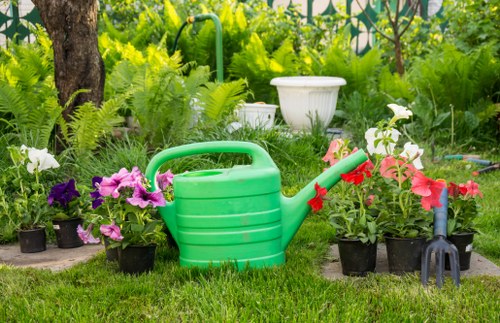Hedge Trimming in Garden Landscape Gardeners
Introduction to Hedge Trimming

Hedge trimming is an essential aspect of garden maintenance that not only enhances the visual appeal of a landscape but also promotes the health and longevity of the plants. Whether you are a seasoned gardener or a DIY enthusiast, understanding the nuances of hedge trimming can transform your garden into a stunning masterpiece.
Proper hedge trimming involves more than just cutting back overgrown branches. It requires knowledge of the specific types of hedges, the best trimming techniques, and the right timing to ensure optimal growth and appearance.
In this article, we will delve into the various aspects of hedge trimming, providing you with comprehensive insights to help you maintain beautiful and healthy hedges in your garden landscape.
Benefits of Regular Hedge Trimming

Regular hedge trimming offers numerous benefits that contribute to the overall health and aesthetics of your garden. Here are some key advantages:
- Enhances Appearance: Well-trimmed hedges add structure and definition to your garden, making it look manicured and well-kept.
- Promotes Healthy Growth: Trimming encourages new growth, ensuring that your hedges remain dense and vibrant.
- Prevents Pests and Diseases: Removing dead or diseased branches helps prevent the spread of pests and infections.
- Safety: Keeping hedges trimmed reduces the risk of them interfering with pathways, structures, or power lines.
By incorporating regular hedge trimming into your garden maintenance routine, you can enjoy a beautiful and thriving landscape all year round.
Moreover, well-maintained hedges can serve as effective privacy screens, creating a secluded oasis in your own backyard.
Types of Hedges and Their Trimming Needs

Different types of hedges require specific trimming techniques to maintain their shape and health. Understanding the unique needs of each hedge type is crucial for effective maintenance.
Evergreen Hedges
Evergreen hedges, such as boxwood and privet, retain their foliage throughout the year. They require regular trimming to maintain their dense and compact structure. It's best to trim evergreen hedges in late spring or early summer to encourage new growth without causing damage to the plants.
Flowering Hedges
Flowering hedges, like lilac and forsythia, thrive when trimmed after they have finished blooming. This timing ensures that you do not remove the buds that will produce next season's flowers. Light pruning can help shape the hedge, while more extensive trimming may be necessary to control size.
Deciduous Hedges
Deciduous hedges, which lose their leaves in the fall, should be trimmed during the dormant season. This period allows the plants to heal quickly and promotes vigorous growth in the spring.
Essential Tools for Hedge Trimming

Having the right tools is essential for efficient and effective hedge trimming. Here are some must-have tools for gardeners:
- Pruning Shears: Ideal for small branches and precise cuts, pruning shears are a staple in any gardener's toolkit.
- Hedge Trimmers: Whether manual or electric, hedge trimmers allow for faster and more uniform trimming of larger hedges.
- Loppers: For thicker branches, loppers provide the necessary leverage to make clean cuts.
- Protective Gear: Gloves, safety goggles, and sturdy footwear are essential to protect yourself while trimming.
Investing in high-quality tools can make the hedge trimming process more manageable and ensure that your hedges are maintained to the highest standards.
Regular maintenance of these tools is also important to keep them functioning optimally and to extend their lifespan.
Step-by-Step Guide to Trimming Hedges

Trimming hedges may seem daunting, but following a systematic approach can simplify the process. Here's a step-by-step guide to help you achieve professional-looking results:
1. Assess the Hedge
Before you begin trimming, evaluate the current state of your hedge. Identify any dead or diseased branches that need to be removed and plan the overall shape you want to achieve.
2. Gather Your Tools
Ensure that you have all the necessary tools ready. This includes pruning shears, hedge trimmers, loppers, and protective gear.
3. Start Trimming
Begin by removing any dead or damaged branches. Then, proceed to shape the hedge by trimming the sides and top evenly. For formal hedges, use string lines to guide your cuts and maintain symmetry.
4. Clean Up
After trimming, clear away all the cuttings and debris to prevent pests and diseases from taking hold. Composting the clippings is an eco-friendly option.
5. Maintenance
Regularly inspect your hedges and perform light trimmings as needed to keep them looking their best. This ongoing maintenance will reduce the need for heavy trimming sessions in the future.
Common Mistakes to Avoid

While hedge trimming can significantly enhance your garden, certain mistakes can lead to undesirable outcomes. Here are some common pitfalls to watch out for:
- Over-Trimming: Removing too much foliage can stress the plant and inhibit healthy growth.
- Improper Timing: Trimming at the wrong time of year can affect flowering and overall plant health.
- Using Dull Tools: Sharp tools make cleaner cuts, reducing the risk of disease and promoting faster healing.
- Ignoring Plant Type: Different hedges require different trimming techniques. Failing to consider the specific needs of your hedge species can lead to poor results.
By being aware of these common mistakes, you can ensure that your hedge trimming efforts are both effective and beneficial to your garden.
Remember, patience and attention to detail are key to achieving the best results when maintaining your hedges.
Advanced Trimming Techniques

For those looking to take their hedge trimming to the next level, several advanced techniques can enhance the appearance and health of your hedges.
Topiary Art
Topiary involves shaping hedges into intricate and decorative forms, such as animals, geometric shapes, or abstract designs. This art form requires precision and creativity, making it a delightful addition to any garden.
Feathering
Feathering is a technique that involves making slight, staggered cuts to create a softer, more natural appearance. This method helps prevent harsh lines and promotes a fuller look.
Renewal Pruning
Renewal pruning involves selectively cutting back older branches to encourage new growth from the base. This technique revitalizes the hedge and can extend its lifespan.
Height Control
Maintaining the desired height of your hedges is essential for both aesthetics and practical purposes. Regular trimming ensures that your hedges do not become overgrown and interfere with structures or pathways.
Seasonal Hedge Trimming Tips

Different seasons offer unique opportunities and challenges for hedge trimming. Adapting your trimming practices to the seasons can yield better results.
Spring
Spring is an ideal time for general maintenance and shaping. As new growth begins, trimming helps direct the energy into strengthening the hedge.
Summer
During the summer, focus on light pruning to maintain shape and prevent excessive growth. Ensure adequate watering to support the plants through their active growing period.
Autumn
In autumn, prepare your hedges for the dormant winter months by removing any weak or damaged branches. This helps protect the hedge from harsh weather conditions.
Winter
While winter is generally a dormant period for hedges, minimal trimming can be done if necessary. Avoid heavy pruning to prevent stress on the plants during the colder months.
Choosing the Right Hedge Trimming Service

For those who prefer professional assistance, selecting the right hedge trimming service is crucial. Here are some factors to consider when making your choice:
- Experience and Expertise: Look for a service with a proven track record and specialized knowledge in hedge trimming and garden maintenance.
- Customer Reviews: Positive testimonials and reviews can provide insight into the quality of service you can expect.
- Tools and Equipment: Ensure that the service uses modern and well-maintained equipment to achieve the best results.
- Pricing: Compare pricing structures to find a service that offers good value without compromising on quality.
By carefully evaluating these factors, you can choose a hedge trimming service that meets your needs and helps maintain the beauty of your garden landscape.
Don't hesitate to reach out and discuss your specific requirements to ensure that you receive personalized and effective service.
Eco-Friendly Hedge Trimming Practices

Adopting eco-friendly practices in hedge trimming not only benefits your garden but also contributes to environmental sustainability. Here are some ways to trim your hedges responsibly:
Use Manual Tools
Opting for manual hedge trimmers or shears reduces carbon emissions and noise pollution compared to electric or gas-powered tools.
Compost Clippings
Instead of disposing of cuttings, compost them to create nutrient-rich soil that can enhance garden health.
Water Conservation
After trimming, ensure that your hedges are properly watered to support their recovery and growth, especially during dry periods.
Natural Fertilizers
Using organic fertilizers instead of chemical ones promotes healthier soil and reduces the risk of harming beneficial insects and microorganisms.
Maintaining Your Tools

Proper maintenance of your hedge trimming tools ensures they remain effective and safe to use. Here are some maintenance tips:
- Cleaning: Remove any sap, dirt, or debris from your tools after each use to prevent rust and maintain sharpness.
- Sharpening: Regularly sharpen blades to ensure clean cuts, which are essential for the health of your hedges.
- Lubrication: Apply oil to moving parts to keep them functioning smoothly and prevent corrosion.
- Storage: Store your tools in a dry place to protect them from moisture and environmental damage.
By taking care of your tools, you can extend their lifespan and ensure that they perform optimally whenever you need them.
Investing time in tool maintenance ultimately saves you money and enhances the efficiency of your hedge trimming activities.
Conclusion

Hedge trimming is a vital component of garden landscape maintenance that offers both aesthetic and health benefits for your plants. By understanding the different types of hedges, utilizing the right tools, and following proper trimming techniques, you can achieve a beautiful and thriving garden.
Regular and mindful hedge trimming not only enhances the visual appeal of your landscape but also promotes the overall well-being of your plants, ensuring they remain robust and vibrant year after year.
Whether you choose to undertake hedge trimming yourself or opt for professional services, the key to success lies in consistency, attention to detail, and a commitment to eco-friendly practices.
Contact us today to learn more about our expert hedge trimming services and take the first step towards a more beautiful and healthy garden landscape.



